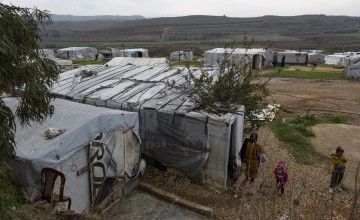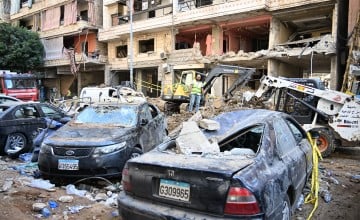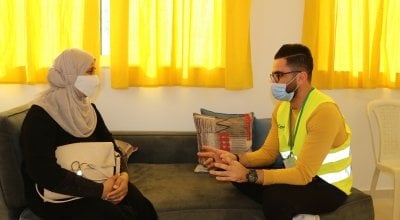
Read our 2023 annual report

Knowledge Hub
Since September 23, 2024, an escalating conflict in Lebanon has led to widespread displacement and suffering for civilians.
On October 8, the government reported that 1.2 million people are now displaced (almost one quarter of the population), and roughly 1.1 million of these have fled in the last three weeks alone.
The scale of recent violence has been especially worrying. The Lebanese Ministry of Health has reported over 2,300 deaths since the conflict began in October 2023; 1,297 of these have been since 17 September 2024. For context, during the last conflict in 2006, 1,300 people were killed over 34 days.
“The fear is overwhelming,” says Concern Lebanon Country Director Sherzada Khan. “Each blast shakes the area around you and causes immense panic and fear. People are obviously living in terror of what will happen next.”
Concern has been in Lebanon since 2013 and has launched a response to the rapidly-evolving emergency. Here’s what you need to know.
Support Concern's emergency response in Lebanon
1. Approximately 1.2 million people are now displaced
Armed confrontations have been displacing people in southern Lebanon for the last year, with over 111,000 people uprooted before a sharp escalation in conflict on September 23. After a week of intensified fighting, the government reported on September 30 roughly 900,000 fled in one week. Now, as of October 8, a total of 1.2 million people are displaced.
This is a major displacement for a country with a population of just over 5 million. Many families have relocated to Beirut and Mount Lebanon, but others have arrived in Tripoli and Akkar (where Concern operates). The latest estimate from the UN’s International Organisation for Migration (IOM), released on October 14 , reports that around 25% of displaced people are living in collective shelters.
2. Refugees in Lebanon face greater challenges and impossible choices
Per capita, Lebanon is the largest host country for refugees. Out of a population estimated by the World Bank at 5.3 million people, 1.5 million are refugees. Most are from neighbouring Syria. Approximately 795,000 are registered with the UN’s High Commissioner for Refugees (UNHCR). Unlike their Lebanese counterparts, displaced Syrian families are unable to access the collective shelters, and face more limited options for shelter and protection.
As of October 5, the UNHCR has reported approximately 220,000 people fleeing to Syria in order to escape violence. The humanitarian situation in Syria remains dire, with protracted conflict and the effects of the 2023 earthquake leaving critical infrastructure compromised and millions of civilians in need of humanitarian assistance amid critical underfunding. The UNHCR’s commissioner, Filippo Grandi, said last week: “It is yet another ordeal for families who previously fled war in Syria only now to be bombed in the country where they sought shelter. The Middle East cannot afford a new displacement crisis.”

3. Lebanon had been dealing with other challenges before this latest escalation
“Lebanon has been through so much already in recent years,” says Concern’s Sherzada Khan. The country has continued to deal with the long-term impacts of the COVID-19 pandemic and the 2020 Beirut port explosion.
It is also facing what the World Bank considers to be one of the worst economic crises since the 19th Century. The country recorded triple-digit inflation in 2023 (over 221%), and the Lebanese lira devalued by over 98% between January 2023 and March 2024.
“The Middle East cannot afford a new displacement crisis.”
4. Poverty rates in Lebanon have more than tripled over the last decade
These economic challenges have become personal challenges for nearly half of the country’s population. A May 2024 World Bank report revealed that 44% of the country’s population live below the poverty line, representing a more-than-200% increase since 2012.
These rates, which were reported prior to the current escalation in conflict, are significantly higher in parts of the country that rely on agriculture and construction, including Akkar — where the poverty rate is estimated to be at 70%. The World Bank also reports that the poverty gap (the amount between an income and the poverty line) has widened from 3% in 2012 to 9.4% in 2022. Once again, these consequences are also felt more acutely among refugees living in Lebanon. It’s estimated that 90% of Syrians in the country are living below the poverty line.

5. Currently, there isn’t enough humanitarian funding to reach everyone affected
In addition to the scale of violence, the scale of response needed has also become a challenge. Prior to the escalation of violence last month, the UN’s Lebanon humanitarian appeal for 2024 had already been underfunded.
“What we need now urgently is more funding so we can provide safe shelters and core relief items to improve hygiene and living standards, like diapers, soaps, and blankets,” Khan adds. “With more funding we could also provide more emergency cash assistance so people can buy food and essential needs.”
The crisis in Lebanon: Concern's response
Concern has been in Lebanon for over a decade, working with both refugee and Lebanese national families in particularly vulnerable situations. Part of that work had been focused on rehabilitating buildings to provide safe and dignified shelter to people fleeing conflict.
We are working with the UNHCR and Lebanese Red Cross to scale up this work, locating and rehabilitating more buildings to use as additional accommodation, including rehabilitating water, sanitation, and hygiene access. We are also providing emergency cash assistance ($90 per family over a period of three to six months), as well as psychological first-aid to children who have been displaced by the fighting.




